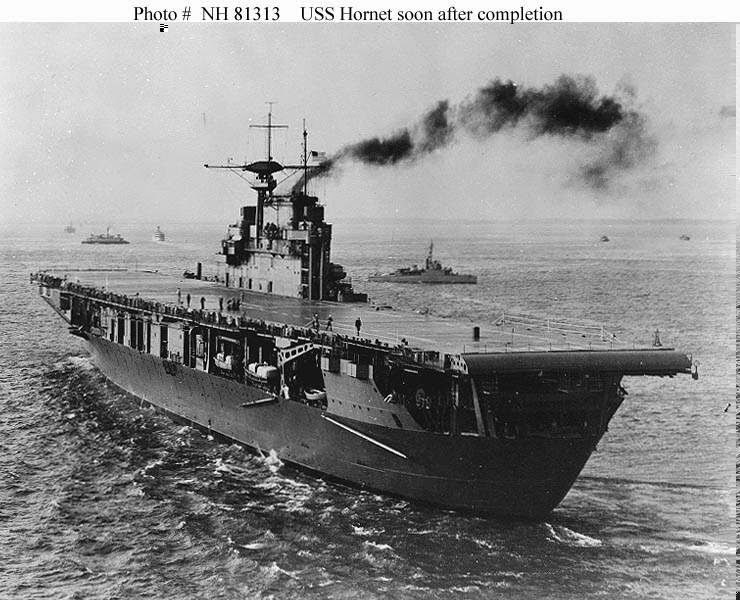Crew No. 1 (Plane #40-2344, target Tokyo): 34th Bombardment Squadron, Lt. Col. James H. Doolittle, pilot; Lt. Richard E. Cole, copilot; Lt. Henry A. Potter, navigator; SSgt. Fred A. Braemer, bombardier; SSgt. Paul J. Leonard, flight engineer/gunner. (U.S. Air Force photo)
Eight of the surviving 16 Doolittle Raiders raise their goblets for their fallen brothers during their 64th reunion in Dayton, Ohio, April 18, 2006. (U.S. Air Force photo by Tech. Sgt. Cecilio M. Ricardo Jr.)
Lt. Col. Jimmy Doolittle accepts a medal from the skipper of the USS Hornet, Capt. Marc A. Mitscher. The medal, once given to a U.S. Navy officer by the Japanese, was wired to a 500-pound bomb for return to Japan "with interest." (U.S. Air Force photo)
The Mission and the Man
In January 1942, Gen. Henry "Hap" Arnold selected Lt. Col. James Doolittle to lead Special Aviation Project No. 1, the bombing of Japan. Doolittle, who enlisted in the Army in 1917, became a flying cadet and received his commission in 1918. In the late 1920s and the early 1930s, he won the prestigious Schneider, Bendix and Thompson aviation trophies. He made the first blind flight in 1929 during which he took off, flew and landed while being completely dependent upon aircraft instruments. Doolittle left the Army Air Corps in 1930, but when war appeared imminent, in 1940 he returned to active duty. Although the Doolittle Raid of April 18, 1942, caused only minor damage, it forced the Japanese to recall combat forces for home defense, raised fears among the Japanese civilians, and boosted morale among Americans and our Allies abroad.
North American B-25B Mitchell
The B-25 medium bomber was one of America's most famous airplanes of World War II, and more than 9,800 were built. It saw duty in every combat area, being flown by the Dutch, British, Chinese, Russians and Australians in addition to U.S. forces. Although the B-25 was originally intended for level bombing from medium altitudes, Pacific Theater aircrews often used it at low level to attack Japanese airfields and strafe and skip bomb enemy shipping.
The U.S. Army Air Forces chose the B-25 for the Doolittle Raid because it was the only aircraft available with the required range, bomb capacity and short takeoff distance. The B-25Bs and 24 trained volunteer crews came from the 17th Bombardment Group, Pendleton Field, Ore.
The airplane on display at the museum is a B-25D rebuilt by North American to the configuration of a B-25B used on the Tokyo Raid. It was flown to the museum in April 1958.
The Training
The crews selected for the mission received their training at Eglin Field, Fla. Lt. Henry L. Miller, a Navy pilot from Pensacola Naval Station, provided assistance on how to take off within 300 feet, the available distance on the carrier USS Hornet. The crews also practiced cross-country and night flying, navigating without radio references or landmarks, low-level bombing and aerial gunnery. They completed their training in mid-March and later flew to San Francisco to board the carrier.
The Bombsight
Instead of the Norden bombsight, which was ineffective at low altitudes, Capt. C. Ross Greening, pilot and armament officer for Doolittle's group designed a replacement bombsight (seen in the nose of the aircraft). This bombsight was connected to the cockpit through the pilot direction indicator, allowing the bombardier to give the pilot aircraft turn directions without relying on voice communication. Using materials costing 20 cents, the metal working shops at Eglin Field manufactured the bombsights.
The Aircraft Carrier
The newly-built aircraft carrier USS Hornet was chosen to carry Doolittle's B-25s toward Japan. In March it sailed to Alameda Naval Air Station near San Francisco to load the Army Air Forces aircraft, 72 officers and 64 enlisted men. On April 2, 1942, not wanting to sail at night because of an inexperienced crew, the Hornet's captain, Marc A. Mitscher, left for the secret mission in broad daylight.




















No comments:
Post a Comment